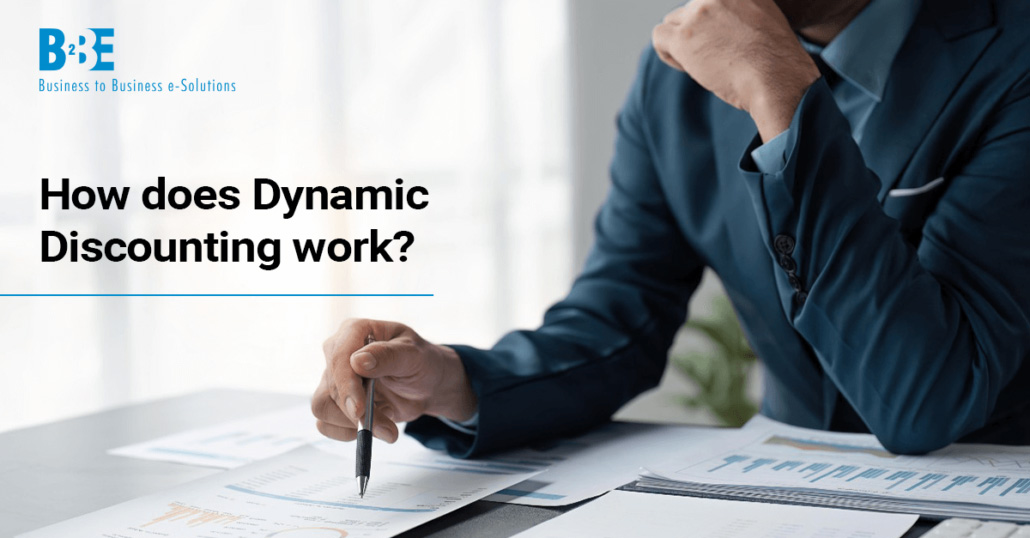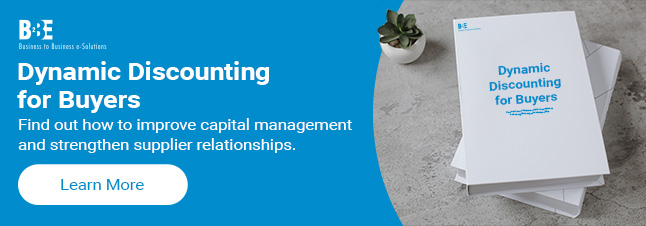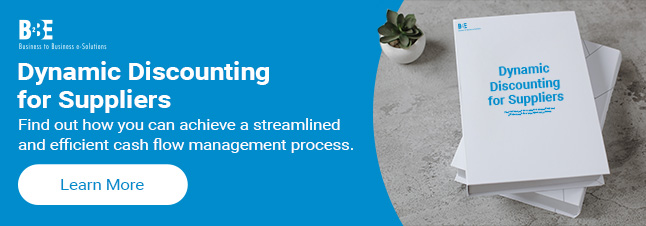This blog will explore how dynamic discounting works, from the invoice to payment process, and delve into the key components and interactions of dynamic discounting solutions. Let’s take a closer look at how dynamic discounting works in practice and the benefits it offers to both buyers and suppliers.
Cash flow is king – and organisations around the world are turning to powerful solutions to maximise cash flow management and gain access to funds quicker while enjoying discounts: Dynamic Discounting.
Long payment cycles, and cash flow gaps can create significant challenges for both buyers and suppliers and, that’s where dynamic discounting comes into play as a game-changing solution that allows businesses to optimise their cash flow by offering or receiving early payment discounts on invoices.
Dynamic Discounting Process Explained: From Invoice to Payment
Dynamic discounting involves a streamlined process that benefits both buyers and suppliers, offering a win-win solution for optimising cash flow. Let’s take a closer look at how dynamic discounting works, from invoice submission to payment processing.
How Does Dynamic Discounting Work For Buyers:
1. Invoice Submission
The process begins with the buyer submitting invoices electronically to the dynamic discounting platform, which serves as a centralised hub for managing invoices and facilitating communication with suppliers.
2. Early Payment Discount Offer
The buyer has the option to offer early payment discounts to suppliers in exchange for quicker payments. The discount is calculated based on the agreed-upon terms and conditions set by the buyer.
3. Discount Acceptance
Suppliers receive the early payment discount offer. They have the flexibility to accept or decline the offer based on their cash flow needs and business priorities.
4. Payment Processing
Once the supplier accepts the early payment discount offer, the dynamic discounting platform processes the payment to the supplier within the agreed-upon timeframe, providing quicker access to funds compared to traditional payment cycles.
How Does Dynamic Discounting Work For Suppliers:
1. Invoice Submission
Suppliers submit their invoices electronically to the dynamic discounting platform, which serves as a central platform for invoice management.
2. Discount Acceptance
Suppliers receive early payment discount offers from buyers. They can accept or decline the offers based on their cash flow needs and business priorities.
3. Payment Processing
If the supplier accepts the early payment discount offer, the dynamic discounting platform processes the payment to the supplier within the agreed-upon timeframe. As a result of this, providing quicker access to funds compared to traditional payment cycles.
Dynamic discounting allows buyers to offer early payment discounts to suppliers, incentivising them to accept quicker payments and improving cash flow management for both parties. Suppliers can benefit from receiving early payments, allowing them to address cash flow gaps and access funds more quickly to meet their business needs.
Key Components and Interactions
A dynamic discounting solution typically comprises several key components. These components work together to streamline the invoice-to-payment process and facilitate early payment discounts. Let’s explore these components and their interactions.
- Invoicing Platform: The invoicing platform is a central component of a dynamic discounting solution. It allows buyers and suppliers to submit, process, and approve invoices electronically, automating the workflow and reducing manual efforts.
- Discount Calculation: The discount calculation component determines the discount amount or percentage based on the agreed-upon terms and conditions set by the buyer. It takes into account factors such as the payment date, discount rate, and invoice amount to calculate the early payment discount.
These components interact with each other to facilitate the dynamic discounting process. When a buyer offers an early payment discount to a supplier, the discount calculation component calculates the discount amount based on the agreed-upon terms. The supplier then reviews and accepts the discount offer on the invoicing platform. This triggers the payment processing component to initiate the payment process. Once the payment is processed, it provides quick access to funds for the supplier, optimising their cash flow.
Benefits of Dynamic Discounting Solutions for Buyers and Suppliers
Using a dynamic discounting solution offers several benefits for both buyers and suppliers:
- Improved Cash Flow: Dynamic discounting allows buyers to optimise cash flow by offering early payment discounts to suppliers in exchange for quicker payments. Suppliers, in turn, gain access to funds faster, helping them manage their cash flow more effectively.
- Enhanced Supplier Relationships: Dynamic discounting promotes better communication and negotiation between buyers and suppliers, strengthening their trading relationships. Suppliers appreciate the flexibility and transparency of the process, leading to improved supplier satisfaction and loyalty.
- Cost Savings: Buyers can capture savings by negotiating favourable early payment discount terms with suppliers. This results in reduced costs and improved profitability.
- Streamlined Invoice-to-Payment Process: Dynamic discounting solutions automate the invoice-to-payment process, reducing manual efforts and errors associated with traditional payment methods. It improves efficiency and reduces administrative overheads for both buyers and suppliers.
Dynamic Discounting solutions offer key components such as the invoicing platform, and discount calculation that work together to streamline the invoice-to-payment process and facilitate early payment discounts. The interactions between these components enable quick and efficient payments, improving cash flow management for both buyers and suppliers, enhancing supplier relationships, and generating cost savings.


